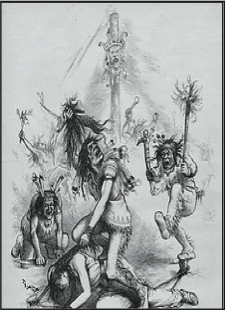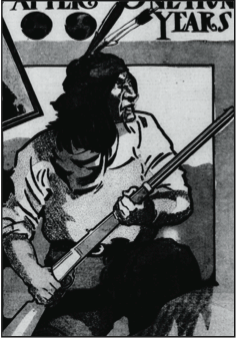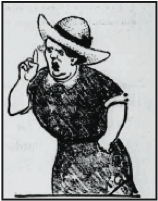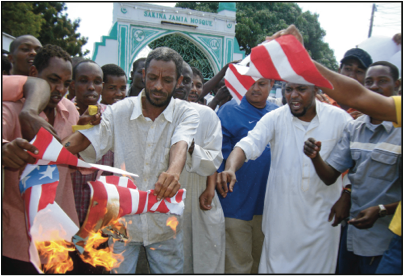From Elon Journal of Undergraduate Research in Communications VOL. 4 NO. 1Visual Persuasion: The Media's Use of Images in Framing People GroupsVII. African AmericansSimilar to the Suffrage Movement, the Civil Rights Movement posed a serious threat to the status quo and the ability of the white male to hold onto his traditional base of power within society. With the rise in popularity and availability of television, TV news reports brought the violence of the movement into the living rooms of the American people. But while video cameras showed the reality of the fight for equality, printed publications still very much relied on biased word choice, emphasis on the negative, and sensational images to subjugate African Americans to the position of "other" within society. While detailed in their coverage of all race-related issues, most newspapers fell short in one important area: "…[they] showed their propensity to cover the hot and simple story, not the complex one; they were drawn to the raging fire, not to the slow burn, so the successful boycott on the Negro side of the racial line went on for weeks with little notice."51 The general public was not so much drawn in by the stories of success, but more so by the tales of conflict, a force that is, in many ways, the heart of news coverage. In the years since the conclusion of the Civil Rights Campaigns, some newspapers have issued public apologies for what they believe to be weaknesses in their coverage, including the Kentucky Herald-Leader and Birmingham News, with reporters and editors admitting their stories were influenced by internal forces of the organization and, externally, political leaders of the era.52 The images that were published during the Civil Rights Movement draw much of their meaning from the accompanying text, which provides important context that explains the media's coverage: "[It] told modern myths of heroes and villains, good and bad, that defined the photographs' meaning for us."53 Images of African Americans generally fell into two categories: (1) photographs of African Americans engaged in Civil Rights Activities, while usually being opposed by white authority; and (2) political cartoons highlighting the differences of African Americans, as mirrored by society. The iconic image of anti-Black, anti-Communist Bull Connor, holding a German shepherd as it lunged toward a defenseless black man (Figure 13) took on different meanings in different publications, largely dependent upon the text within the accompanying story. While some, such as The New York Times strove to remain neutral by not placing blame on either involved party, others were more direct in their pointed language, such as Newsweek. In a May 1963 edition, the popular news magazine wrote about "angry mobs of Negroes" within a story titled "Look at them Run," a reference to a statement made by Connor. Printed in its entirety within the story, the magazine was derogatory toward the participants: “’Look at those niggers run,’ he beamed as five dogs bounded out of police cars and set the crowd backpedaling. Some of the negroes darted up close, woofing back at the dogs. One stripped off his red shirt and waved it like a matador’s cape.”54 The imagery here is striking, as the reporter suggests that the African American participants were attempting to rile the dogs and provoke them to attack. In coverage of the same image, Time was quick to draw a distinc- tion between good and evil, right and wrong when describing the scene of the event, emphasizing the fact that there was a clear distinction between the two races, while also describing the scene in mildly racist terms: blacks in Birmingham were a “docile lot,” while Martin Luther King, Jr. was “inspirational but inept.”55 Unlike previous images that clearly rallied for or against a par- ticular group, the images of the Civil Rights Movement were, at times, left up to interpretation, as “journalists, politicians, local Southern authorities, and civil rights activists vied for the power to construct meaning for the nation.”56 Though not as often, African Americans were also represented by drawings and cartoons that often reflected those characteristics differentiating them from the rest of society, particularly their skin color. Unlike previous coverage of racial groups, this was more a reflection of deeply rooted cultural beliefs, and less about the press promoting a particular way of viewing African Americans. In many ways, the press was simply acknowledging the existing divides, based on color, which existed at the time. In a 1963 editorial, The New York Times suggests that the staff of the paper viewed racism as an entrenched problem that could not easily be addressed: "We do not expect that there will be overnight rejection of all the policies that caused so much distress to the Negro community. The Rev. Dr. Martin Luther King Jr. and other leaders of the drive to break down racial barriers ought not to expect it either."57 Figure 14 shows a cartoon from a 1963 edition of the Washington Post, which highlights the ingrained beliefs about color as the determining factor in limiting the rights of African Americans in society. In many ways, the images that characterized African Americans in the press served to portray them as the "other" while, in some cases, also showing the audience the brutality of how they were being treated by the white establishment, such as Figure 13. In most cases, the accompanying text was particularly important in attaching meaning and context to an image, which could be taken a number of different ways, based on how the publication chose to write about the visual and the event it represents. While still pointed, the treatment of African Americans through visual was not as blatant as the treatment of the people groups that came before them. VIII. Muslim AmericansThe tipping point that propelled Muslim Americans into the media spotlight was, of course, 9/11. This major catastrophic event served as the catalyst that moved Muslim Americans from the periphery and into the forefront of the United States' mindset and necessitated extensive coverage by the press: "Whether traveling, driving, working, walking through a neighborhood, or sitting in their homes, Arabs in America – citizens and non-citizens – are now subject to special scrutiny in American society. The violence, discrimination, defamation, and intolerance now faced by Arabs in American society has reached a level unparalleled in their more than 100-year history in the US."58 When the terrorist attacks occurred that September morning, the public, with little prior knowledge of Muslim Americans, looked first to the media when attempting to make sense of the situation and the people. When the media portrayed correctly the attackers as Muslim, a connection was made between the followers of the religion and the act of terrorism and direct violent actions followed at the hands of the American public. The frame of Muslim Americans at the hands of the media was created on September 11, 2001, and the public subsequently responded. Images of Muslims Americans generally fall into two categories: (1) photographs of Muslim anger and violence against the west, that tied all Muslims to this fury; and (2) images from within local stories immediately sensationalized and played up by the national media. As was the case with African Americans, the context and text with which the image is accompanied is particularly important. In the wake of 9/11, Muslim Americans were particularly tied to their countries of origin, such that their American side was de-emphasized and they were portrayed as not part of the larger national community, effectively portraying them as "the other" and to be feared. The public reaction against Muslim Americans was swift and covered extensively by the media and little to no distinction was given to the differentiation between Muslim Americans and the terrorists who carried out the attack. In the immediate wake of 9/11, The New York Times ran a story containing quotes from Phil Beckwith, who was filled with violent fury against all followers of Islam: "'I know just what to do with these Arab people,' … 'We have to find them, kill them, wrap them in a pigskin and bury them. That way they will never get to heaven.'"59 Figure 15 was featured on the front page of Newsweek in September 2012 alongside the headline "Muslim Rage." While the image itself is not one of Muslim Americans, the accompanying, controversial story ties all followers of Islam to such violence: "In the age of globalization and mass immigration, such intolerance has crossed borders and become the defining characteristic of Islam."60 Islam and Muslims are tied to key, inflammatory words, including "eruption," "indignation," and "violent"-and that's only within the first paragraph of the story.61 While voices and perspectives of Muslim Americans did exist, unlike the coverage given to Native Americans, they were often drowned out by the negative and often violent cries against them. And the written word did not go without serious consequence. For example, an innocent Muslim American was shot 35 times at point blank range by Mark Anthony Stroman, who went on a post-9/11 killing rampage. On Long Island, a 75-year-old man tried to run over a Pakistani woman at a shopping mall, threatening to kill her for "destroying my country." The examples go on and on, and researchers and Muslim Americans alike contend the media have played a direct role in the largely negative treatment toward the group. In a research study conducted with anonymous Muslim Americans in the wake of 9/11, one woman was clear in her blame: "I blame the media for the ignorance of the people, because they sit there and they make Muslims seem as if they are bad people and that they are terrorists. They're aggressive . . . they don't think... You know, they have no morals, no values. And, like, the media plays a big role in [this] . . . they always show that we are negative."62 Another framing technique used by the media in the case of Muslim Americans was the sensationalization of local stories, which were picked up by the national media and overplayed. In many cases, these revolved around discrimination against Muslims and were accompanied by inflammatory images. Normally, such stories would not reach the national level but, because of the inferior status of Muslim Americans within society, they became more prevalent. Just a few examples include the Dove World Outreach Center, pictured in Figure 17, which has been outspoken in its criticism of the religion. The image of the "Islam is of the Devil" sign placed in front of their building was widely circulated among publications. Just a few years ago, the media were overtaken with reports about the "ground zero mosque," in reality, an Islamic community center in lower Manhattan. The coverage was met with outrage and protests across the country, even though the impact would only be felt in the local New York community. The vast majority of stories about Muslim Americans involve stereotyping, mistreatment, or anger toward Islam and never portray the positive side of the religion, such as its cultural practices, good works in the community, etc. Similarly, images often highlight either the reactions against Muslims or, as numerous researchers have pointed out, the differences that mark the religion.63 While reporters were certainly not as blatant in name calling, as they were with the Natives, the types of stories reported and the speed with which they spread across the nation were as just as negative toward the group.Continued on Next Page » Suggested Reading from Inquiries Journal
Inquiries Journal provides undergraduate and graduate students around the world a platform for the wide dissemination of academic work over a range of core disciplines. Representing the work of students from hundreds of institutions around the globe, Inquiries Journal's large database of academic articles is completely free. Learn more | Blog | Submit Latest in Business & Communications |


































